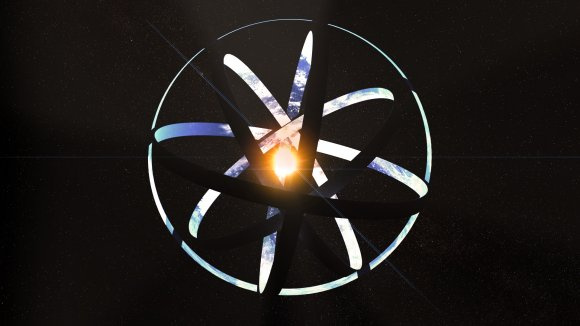Advanced civilizations can build the galactic internet using planet passages.

Search for extraterrestrial intelligence
Decades later, as Enrico Fermi said his famous words: “Where is everyone?” - the paradox that bears his name still haunts us. Despite repeated attempts to find radio signals emanating from space and our constant efforts to search for visible signs of foreign civilizations in distant stellar systems, the search for extraterrestrial intelligence (SETI) has not yet found anything significant.
But, as history has taught us, failures stimulate new and interesting ideas. For example, in a recently published article, Dr. Duncan H. Forgan of St. Andrews University proposed that extraterrestrial civilizations could communicate with each other using the transit method. With the help of this “galactic internet”, advanced species may try to send signals to us right now.
Soon, Forgan ’s article “Passage of Exoplanets as the Basis of the Interstellar Communication Network” was published . In addition to being a research fellow at the School of Physics and Astronomy , as well as the Scottish University Physical Alliance at the University of St. Andrews (the oldest educational institution in Scotland), he is also a member of the St. Andrews Center for the Study of Exoplanets .
The article begins with a review of two fundamental problems associated with interstellar communication — time and energy consumption. When it comes to things like radio broadcasts, the amount of energy that will be needed to transmit a consistent message over interstellar distances is enormous. Optical communications (ie, lasers) need less energy, but their detection will require incredibly accurate time.
Thus, none of the methods would be reliable for creating an interstellar communication system. Taking into account recent efforts to detect exoplanets, Forgan argues that the method of transmission in front of the stars, which is the basis of communication, solves both problems. The reason for this is largely due to the fact that the transit method is currently one of the most popular and reliable methods for detecting exoplanets.
By observing periodic decreases in brightness that are caused by a planet or an object passing between an observer and a star, astronomers can determine if a star has a planetary system. This method is also useful for determining the presence and composition of the atmosphere around an exoplanet. As Forgan points out in a document, this method can be used as a means of communication for other civilizations:
“ETI 'A' can communicate with ETI 'B' if B observes the passage of the planet in the star system A, either by creating structures for artificial passages observed by B, or by emitting signals B during the passage with a significantly lower energy consumption than conventional electromagnetic transmission circuits. "(ETI is an acronym for Extraterrestrial Intelligence .)

Inhabited zone of the Milky Way. Image source: NASA / Caltech
In short, Forgan argued that in the Galactic Habitable Zone (GHZ) - the Milky Way region where life is most possible - the species may find that the best way to communicate with each other is to create artificial megastructures for the passage of their star. These passages, which will be sought by other civilizations, will lead them to the conclusion that there is a developed civilization in another star system.
He even offers estimates of how often such transfers can be made. According to him:
“A message with a range of 20 kiloparsecs (diameter GHZ) has a total travel time at a speed of light less than 0.06 million years. If we assume a relatively short period of time during which both ETIs remain in the transit zone for 100,000 years (which approaches the time scale on which both the evolution of the planetary orbits and the star's orbit are important), then only 30 exchanges can be made. This, of course, does not prohibit communication in other ways. "
The possibility of extraterrestrial life
If this is familiar to you, it is probably because, according to some theorists, this is happening around KIC 8462852. Even in May 2015, astronomers noticed that over the past few years, the star has seen a significant decrease in brightness. This behavior was contrary to the natural explanations that led some to argue that this may be the result of someone else's megastructure passing in front of a star.
According to Forgan, this possibility is hardly contrived and will actually be a relatively economical means of communicating with other advanced species. Using graph theory, he calculated that civilizations within the GHZ could create a fully connected network for a million years, where all civilizations communicate with each other (either directly or through intermediate civilizations).

KIC 8462852, which over the past few years has experienced unusual changes in brightness, in the artist's view. Image source: NASA, JPL-Caltech
Not only will this network require much less energy to transmit data, but the range of any signal will be limited only by the scale of these civilizations themselves. In addition to saving energy and increasing the range (provided that intermediate civilizations can transmit messages), this method provides other advantages. First, to ensure the passage of exoplanets will require a high level of technological complexity.
In other words, civilizations need to reach a certain level of development before they can hope to join the network. This would prevent any unsuccessful “cultural pollution” when less developed civilizations learned about the existence of aliens before they were ready. Secondly, when they are received, the signals of the transit network will be extremely predictable, with each transmission corresponding to a known orbital period.
But there are some drawbacks that Forgan noticed. The frequency of these signals would be a double-edged sword, since the signals could only be sent when the receiver marked the passage. And although the megastructure can be moved to change the transit period, it creates problems in terms of synchronization of transmission and reception.
Referring to the limitations of the analysis, Forgan also recognizes that the study is based on fixed stellar orbits. It is known that the orbits of stars change over time, for the stars regularly enter and exit the GHZ on space time scales. In addition, there is also the question of how such a network will differ from denser regions in the galaxy, such as globular clusters, and zones filled with free stars. Double stars are also not considered in the analysis.

Can extraterrestrial megastructure be the key to interstellar communication? Image Source: Kevin Gill
It is known that the planetary orbits change over time due to disturbances caused by neighboring planets and stars, or nearby stars. As a result, the visibility of passing planets can change even more in space timescales. Last but not least, the study suggests that civilizations have a natural life cycle of about a billion years, which is not based on any specific knowledge.
However, these considerations do not change the general conclusions made by Forgan. Taking into account the dynamic nature of stars and planets and assuming that civilizations exist for only 1 million years, Forgan argues that the creation of this kind of interstellar network is still mathematically feasible. In addition, an artificial object can continue to signal other species after civilization has died out.
Turning to the Fermi paradox, Forgan concludes that this kind of message will take a long time to be discovered. As he summarizes in the article (bold):
“I believe that at any moment only a few civilizations are properly positioned to communicate through the transit method. However, we should expect that the present network will be cumulative, when a “handshake” at any time guarantees a connection in the future through, for example, electromagnetic signals. In all our simulations, the aggregate network connects all civilizations together into a whole network. If civilizations share knowledge about their connections, the network can be fully completed within a time frame of the order of hundreds of thousands of years. After creation, this network can connect any two civilizations, either directly or through intermediate civilizations, with distances much smaller than the dimensions of the GHZ. ”
In short, the reason we haven’t received or found evidence of ETI may be a matter of time. Or we simply did not understand that we communicated. Although this analysis is based on guessing and, possibly, on anthropocentric assumptions, it is certainly fascinating because of the possibilities that it presents. He also offers us a potential tool for finding extraterrestrial intelligence (SETI), which we are already working on.

So many stars, so many planets. So many connectivity options! Image source: ESO / M. Kornmesser
And last but not least: he offers a potential solution to the Fermi paradox, which we may have already stumbled upon and simply do not yet know about it. As far as we know, the observed decreases in brightness emanating from the star KIC 846285 indicate an alien civilization (possibly extinct). Of course, the key word here is “possible,” since there is no evidence to confirm this.
The opportunities discussed in this article are also interesting, given that the hunt for exoplanets will grow in the coming years. With the deployment of next-generation missions, such as the James Webb Space Telescope and the Transiting Exoplanet Survey Satellite (TESS), we expect to learn much more about star systems in both near and far space.
Will we find more examples of unexplained brightness drops? Who knows. The fact is that if we find them (and do not find them a natural cause), then we have a possible explanation. Perhaps our neighbors invite us to "connect"!


All Articles